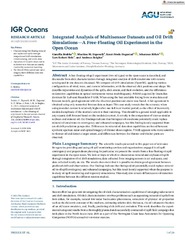| dc.contributor.author | Brekke, Camilla | |
| dc.contributor.author | Espeseth, Martine | |
| dc.contributor.author | Dagestad, Knut-Frode | |
| dc.contributor.author | Röhrs, Johannes | |
| dc.contributor.author | Hole, Lars Robert | |
| dc.contributor.author | Reigber, Andreas | |
| dc.date.accessioned | 2021-01-28T09:14:12Z | |
| dc.date.available | 2021-01-28T09:14:12Z | |
| dc.date.issued | 2021-01-20 | |
| dc.description.abstract | A free‐floating oil spill experiment (two oil types) in the open ocean is described, and the results from slick characterization through integrated analysis of drift simulations with remote sensing and in situ data are discussed. We compare oil drift simulations (OpenOil), applying various configurations of wind, wave, and current information, with the observed slick positions and shape. We describe trajectories and dynamics of the spills, slick extent, and their evolution, and the differences in detection capabilities in optical instruments versus multifrequency PolSAR acquired by Deutsches Zentrum für Luft‐und Raumfahrt F‐SAR. When using the best available forcing from in situ data and forecast models, good agreement with the observed position and extent was found. A fair agreement is obtained using only numerical forecast data as input. This case study reveals that the accuracy when using modeled current is relatively higher after one full local inertial period, as the effect of incorrectly modeled amplitude of the inertial current is then vanishing. This should be a general result applicable to any oceanic drift forecast based on the modeled current. A novelty is the comparison of viscous‐similar soybean and mineral oil. Our findings indicate that biological oil emulsions potentially could replace mineral oil emulsions in contingency and rehearsal campaigns, but this finding is only supported from an oil drift prediction perspective. Differences in mineral oil detection capabilities are found between synthetic aperture radar and optical imagery of thinner sheen regions. F‐SAR appears to be more sensitive to thinner oil and detect a larger extent, and differences between the thinner and thicker parts are observed. | en_US |
| dc.identifier.citation | Brekke, C., Espeseth, M. M., Dagestad, K.‐F., Röhrs, J., Hole, L. R., & Reigber, A. (2021). Integrated analysis of multisensor datasets and oil drift simulations—a free‐floating oil experiment in the open ocean. <i>Journal of Geophysical Research: Oceans, 126</i>, e2020JC016499. | en_US |
| dc.identifier.cristinID | FRIDAID 1843173 | |
| dc.identifier.doi | 10.1029/2020JC016499 | |
| dc.identifier.issn | 2169-9275 | |
| dc.identifier.issn | 2169-9291 | |
| dc.identifier.uri | https://hdl.handle.net/10037/20491 | |
| dc.language.iso | eng | en_US |
| dc.publisher | American Geophysical Union | en_US |
| dc.relation.journal | Journal of Geophysical Research (JGR): Oceans | |
| dc.relation.projectID | info:eu-repo/grantAgreement/RCN/SFI/237906/Norway/Centre for Integrated Remote Sensing and Forecasting for Arctic Operations/CIRFA/ | en_US |
| dc.rights.accessRights | openAccess | en_US |
| dc.rights.holder | Copyright 2021 The Author(s) | en_US |
| dc.subject | VDP::Technology: 500::Rock and petroleum disciplines: 510 | en_US |
| dc.subject | VDP::Teknologi: 500::Berg‑ og petroleumsfag: 510 | en_US |
| dc.subject | VDP::Technology: 500::Environmental engineering: 610 | en_US |
| dc.subject | VDP::Teknologi: 500::Miljøteknologi: 610 | en_US |
| dc.subject | VDP::Technology: 500::Information and communication technology: 550 | en_US |
| dc.subject | VDP::Teknologi: 500::Informasjons- og kommunikasjonsteknologi: 550 | en_US |
| dc.title | Integrated analysis of multi-sensor datasets and oil drift simulations - a free floating oil experiment in the open ocean | en_US |
| dc.type.version | publishedVersion | en_US |
| dc.type | Journal article | en_US |
| dc.type | Tidsskriftartikkel | en_US |
| dc.type | Peer reviewed | en_US |


 English
English norsk
norsk